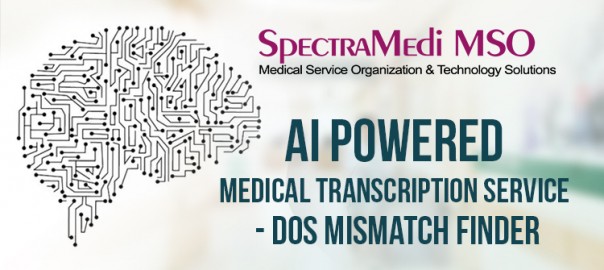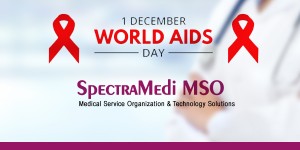
Category Archives: medical transcription


AI Powered Medical Transcription Service – DOS Mismatch Finder
In a medical practice, timely documentation of patient encounter is a very critical factor. Equally important is the accuracy of the data in the patient encounter notes. Apart from the medical terminologies, it is extremely important that the patient demographic information as well as the encounter specific details is entered accurately. It has medical, financial as well as legal implications. Inaccurate information can result in denial of insurance claims or even land the provider in a legal suit. Hence it is very important that due diligence is maintained to ensure that the patient demographic as well as encounter specific information is entered correctly in patient reports.
The Challenge
One of the most important encounter specific information is the Date of Service (DOS). A wrong DOS on the patient’s medical transcription report can land the provider in problems and also result in denial of insurance claims, resulting in revenue loss.
Every medical practice has its own system of managing the medical records. This includes the handling of dictations on patient encounters. The providers use different modes to dictate on patient encounters. It could be a phone-in dictation, digital records or even the latest technology of smart phones (including iPhones). Some practices and providers have the habit of dictating the patient notes at the end of the day of the encounter and uploading on the same day. However some others dictate on the same day of the encounter but they upload the dictations for transcription in bulk later. Usually it could be twice in a week or even once in a week. At times, even within the same practice, different providers could have different ways. However, in most of the cases, there will be regularity in the way dictations are handled.
It was found that the mistakes were because of inaccurate data sent to Transcription Company from the practice. At the time of sending the dictations (especially using digital recorders), the person in the medical records department, who upload the dictations have to select the DOS for the set of dictations. At times, by mistake they happen to select the wrong DOS, resulting in wrong encounter data being typed in the report.
When this is brought to the notice of the provider by the insurance company, the providers blame the Transcription Company for the errors. This leads to a loss of trust in the quality of service provided by the Transcription Company.
AI Powered Medical Transcription – The Solution
AI can play a major role in overcoming this problem. Most of the practices and/or providers have a definite pattern of sending dictations. There were slight divergences, but on the whole a pattern could be mapped out.
Based on the result of the pattern mapping, the AI could arrive at a matrix which gave us the most probable pattern of dictation for a provider. It could be same day dictation, next day dictation, twice in a week or once in week etc. This pattern can be incorporated into transcription system and the value included in the provider/practice profile.
Whenever Transcription Company receives the dictations, the transcribers would enter the DOS based on the information provided from the practice side. AI system would compare the date of dictation and DOS and match it with the value against the provider/practice profile. If there was a divergence which was more than the accepted one, the AI system would throw an alert to the next level (editor or quality analyst) to recheck the DOS. The Editor or QA could reconfirm the DOS and in the case of a doubt flag it to the attention of the practice or provider to take due care.
This artificial intelligence based approach will result in substantial reduction in the usage of wrong encounter specific data, especially the DOS. This also resulted in major confidence boost among the providers with regard to transcription service.
Benefits of Outsourcing Transcription Services to watch out for in 2017
December, it’s the rollicking time of the year! And yes, Christmas is upon us! We’re sending holiday cheer to all our clients and friends. Providing our customers with exquisite service is something we strive to do all year round.
We appreciate our clients and would like to take this opportunity to wish you and yours a festive Holiday Season.
Well, now we are at the end of 2016 season and we would like to bring to your notice about outsourcing transcription services that will increase your healthcare practice’s bottom line in 2017.
Transcription Process involves transcribing the information dictated into text format. Although organizations in industries such as healthcare, legal and education are exploring the many benefits of outsourcing their transcription needs, the concept and benefits of transcription is most known to the medical industry. The advent and increased use of digital voice recorders and speech recognition have made the outsourcing transcription businesses easier while helping operating your healthcare practice at optimum efficiency.
In the challenging times of time and tight budgets, managing medical transcription yourself can cost you in more ways than one; let’s see some of the benefits:
Help to Make Timely Decisions about a Patient’s Care
If a physician has considered outside sources to help with transcription, he/she dictates notes using his/her favorite dictation capture method. In this case, the physician’s workflow and productivity is not affected allowing or giving them the freedom to focus more on their patients without needing to worry about clinical documentation.
Help Solve Time Management Issues and Enjoy Work life
It may take significantly long time to complete clinical documentation if you are using hard-copy charts to make each patient’s treatment and history notes while a professional transcription service will help you type out your oral notes. This is perhaps one of the most time saving benefits of a medical transcription service.
Sometimes failing to manage your work time gets you a nagging feeling that you haven’t done your work properly. By getting help from third-party transcription service providers, the time management issue can be solved to a great extent which helps you enjoy a healthy work life.
Reduce Direct Labor Costs
If you are on low budget and have appointed a direct labor for your medical transcription process, chances are great that the labor cost is putting strain on your already tight budget. You just not need to give them salary, but also have to provide them with benefits. Another issue that comes in between is when they take leave for some days or when they quit from the job. Extra time need to be spent for properly training the new employee.
Outsourcing your medical transcription process help you gain greater control, streamline the operations and greatly reduce the direct labor costs.
Timely Transcription Delivery
Medical documents are transcribed and the dictation is screened many times for errors. The more set of eyes go through the documents, less are the chance of errors. It is not just about an error-free finished document that medical professionals can rely on, transcriptionists knows the importance of timely transcription solutions as well.
Auto-faxing to a Referring Physician
As we know, faxing is one of the important communicative means in medical transcription. Most of the transcription services offer you to fax the transcribed reports to the referral physicians as required.
The dictation is transcribed and then verified by the physician. The medical transcription service is usually designed to fax the report to the referring physicians if subscribed to the Auto-Fax service.
Secondary Repository for Hospital Documentary
Another advantage with a transcription service is that safety of your medical transcription data will be given top priority, so that you don’t want to worry even if you lose the data as the transcription company you choose acts a secondary repository for your hospital documentary.
In a nutshell, Medical transcription service is a up-and coming fast growing segment in the field of next generation patient documentation no doubt that it will change the notion of healthcare industry.
SPECTRAMEDI ADVOCATES SELF-RESTRAINT AND FIDELITY
The World Health Organization has marked eight global health campaigns, and one among them is World AIDS Day, which is observed on December 1. It aims at raising awareness of AIDS and the disastrous consequence caused by the spread of HIV infections and educating on AIDS prevention and control. Irrespective of the government and non-governmental organizations, health officials and individuals, all join hands in this campaign.
SpectraMedi MSO is known for its commitment to the health industry and takes the opportunity to mourn those who have died of the disease, to condole with the bereaved, and to raise awareness on prevention and control. It is meaningless and useless to stand and stare at the ghastly statistics of the AIDS toll and its victims. Since there is no vaccine to prevent HIV infection and no cure for AIDS, the only thing we can do is to safeguard ourselves and others from HIV infections.
Here are some steps to help prevent the spread of HIV.
-
New condom every time. Whenever you have sex, use a new condom.
-
Let your sex partner know your status if you are HIV positive. Your partners also need to be tested and to receive medical care if they have the virus. They also need to know their HIV status lest they infect others.
-
Sterile needle. Make sure the needle you use for injecting drugs is sterile and avoid sharing it.
-
Prompt pregnancy care. If one is HIV positive, one may pass the infection to the baby. However, if treatment is taken during pregnancy, risk can be minimized significantly.
-
Circumcision: Study reveals that male circumcision can considerably reduce a man’s risk of contracting HIV.

